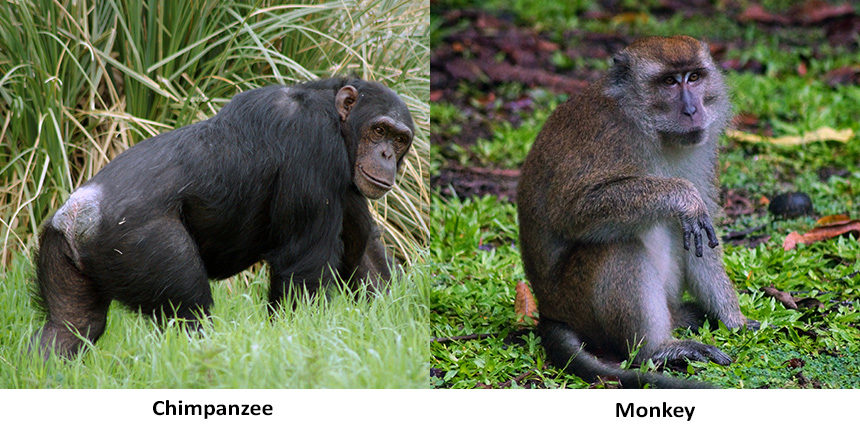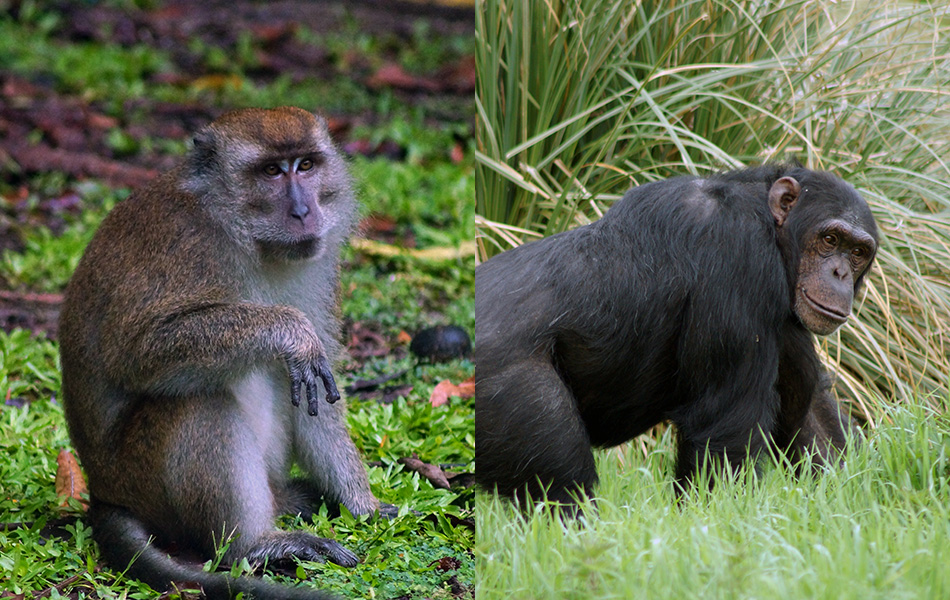Chimpanzees and Monkeys
Non-scientists often make mistakes when talking about science. This is understandable. I’m sure I make mistakes when I talk about politics! But there is one mistake, one seemingly inconsequential error, that I find completely intolerable. The error I am referring to is the routine use of ‘ape’ ‘chimpanzee’ and ‘monkey’ as interchangeable terms for the same entity.
The word chimpanzee refers exclusively to members of a single genus; Pan. This genus contains two species; the common chimpanzee (Pan troglodytes) – what most people think of when they imagine a chimpanzee, and which have been famously humanised in television shows for decades – and the bonobo chimpanzee (Pan paniscus) which is found only in the Demoncratic Republic of Congo.

Chimpanzees are apes, along with Orangutans, Gibbons, Gorrilas and Humans. Generally speaking, apes are primates that lack a tail. Monkeys, on the other hand, generally have a tail, although in some species it has evolved to be very short. Some primates with tails aren’t monkeys, though – lemurs, for example, are not monkeys or apes, but they are primates…. Ok I’m starting to see how this might get confusing. Maybe this family tree will help?
Monkey is a more general term referring to members of the suborder Haplorrhini, which includes around 260 species. Monkeys are divided into new world (Central and South America) and old world monkeys (Africa and Asia). This group encompasses species from a variety of habitats, employing a variety of different lifestyles.
Chimpanzees ARE NOT monkeys (and monkeys are definitely not chimpanzees)

It isn’t open for interpretation. This is the labelling system designed by eminent biologists and agreed upon universally. It is a system that has been in place since 1735, and upon which we have built, added and re-organised with each new advancement in biology. Before Carl Linnaeus, animals were categorised according to their movement, and communication between scientists was confused and difficult. Linnaean taxonomy, the practice of identifying each species by a unique species and genus combination, which can then be further organised into higher-level taxonomic classifications, brought order to our understanding of the natural world. While I accept that common names have their use, and that in everyday life we need short means for referencing different species or groups of species, I do not believe it is acceptable to switch around carefully assigned taxonomic names. It confuses the issue, and frankly it makes you sound stupid.
Furthermore, it isn’t a difficult distinction to remember. I’m sure most people do in fact realise, or, at least, almost everyone would know the difference if they were presented with live examples of the animals in question.
To use the words interchangeably is just lazy. And it makes me cringe. So, please stop it, ok?
Featured image is copyright Claire Asher 2014.






The family tree itself refutes your claim. Do you see how Old World monkeys are more closely related to apes than they are to New World monkeys? That renders the term ‘monkey’ polyphyletic. Because biological names should reflect monophyletic clades, the entire clade comprising New World monkeys, apes, and Old World monkeys can accurately be referred to as “monkeys.”
*Oops, I meant to say that the term monkey, when it excludes apes, is paraphyletic….not polyphyletic.